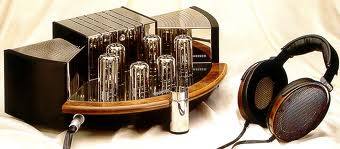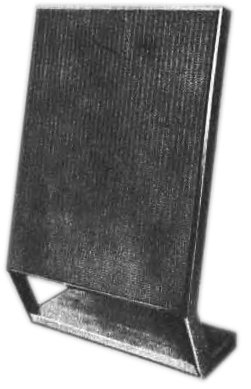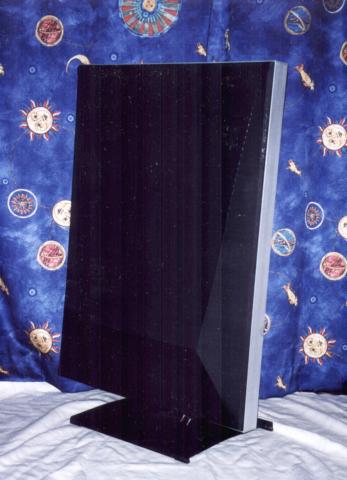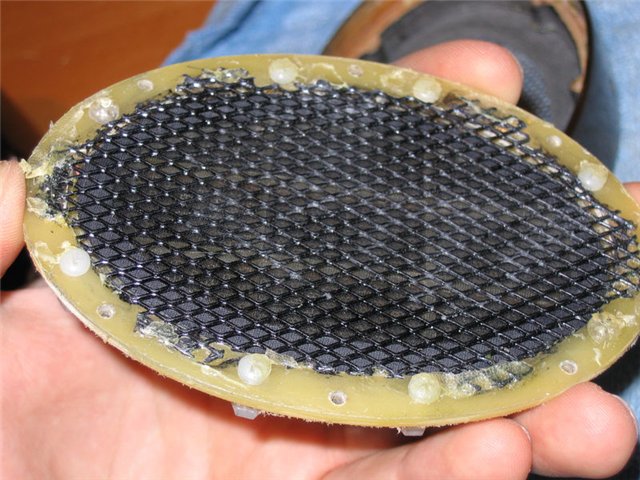Upscale sound: electrostatic sound emitters
Hello. This article, though not in line with the main theme of the site, but I think it will be interesting to many, and maybe even encourage someone to make statics with their own hands.
I am interested in the topic of high-quality sound reproduction, I managed to learn some knowledge, and I had a desire to enlighten the public about not very well-known, but very interesting and simple technology - electrostatic loudspeakers, which, in fact, turned my interest towards audio technologies, especially that several times they were mentioned in the comments, but no one went into details.

Martin Logan CLX
What is an electrostatic loudspeaker? This is one of the most common types of non-traditional sound emitters, based on the principle of electrostatic interaction. Its advantages are extreme simplicity of design and unattainable sound quality for dynamic loudspeakers. It is electrostatics that give the least distortion of all types of sound emitters.
')
Electrostatics were invented in Germany back in the 1880s, the exact date is not known. Since then purely mechanical gramophones were used, the first electrostatics were used in experiments to obtain ultrasound. Only in 1915 did the development of electromechanical, and not purely mechanical, sound reproduction begin. At the same time, experiments began on the use of electrostatics in sound reproduction. In 1922, tube amplifiers were born, and immediately the first commercial electrostatic speaker system was created, designed for the cinema's voice acting. At that time, powerful magnetic materials were not yet developed, and the efficiency of the speakers was lower than electrostatics. Soon electrostatics began to be produced in appreciable, for those times, quantities. Their design was still different from modern ones, for the most part, those statics were single-ended and gave far from ideal sound. In 1927, Hans Vogt created a two-stroke electrostatic sound emitter, which has remained virtually unchanged to this day. But already in 1930, the first sufficiently strong ferromagnets were created, and dynamic sound emitters quickly replaced all other technologies.
The problem with the first electrostatics was the lack of a suitable material for the membrane, usually aluminum foil was used. It did not have sufficient strength and flexibility, and in addition, the names of low resistance, which led to the fact that during the breakdown of the film just burned. In the 1950s, the first solid polymer films appeared, and already in 1953, Arthur Jansen (Arthur Janszen) received a patent for the first practical electrostatic loudspeaker. Started the revival of statics, which coincided with the beginning of the era of stereo. But they did not receive widespread statics, remaining a lot of audiophiles. In 1957, QUAD ESL 57 appeared, a real survivor - it was produced until 1981, and became one of the most widely distributed statics. In 1981 he was replaced by ESL 63, perhaps the most famous of all the statics, who solved one of the problems of this type of sound emitters - a narrow radiation pattern.

QUAD ESL 63
In 1982, at the Consumer Electronics Show in Chicago, Gail Martin Sanders and Ron Logan Sutherland presented their CLS system assembled in the garage — solving the same problem in a simpler way — using a curved panel. Their development received a prize for the design and construction and soon appeared the company Martin Logan, one of the most famous manufacturers of electrostatics in the world.

Martin Logan CLS
In addition to full-sized speakers, statics are used in traditional speakers as high-frequency radiators. In the 1980s, even musical centers with electrostatic "beeper" were produced. There are also electrostatic headphones. In 1960, the Japanese company Stax began production of the first headphones, and to this day remains almost the only manufacturer. Headphone makers such as Sennheiser, AKG, Koss also occasionally produced electrostatic headphones that ranked the highest in the line, for example, the legendary Sennheiser HEV-90, a set of amplifier and headphones, worth about 12 thousand dollars.

Sennheiser HEV-90
And what happened in our country? It must be said that in the USSR statics was developed and produced, and still is produced. In 1977, the ASI named after A.S. Popova developed the first domestic electrostatic ASE-1.

ASE-1
Unfortunately, a simple Soviet citizen had the opportunity to join the world of electrostatic sound only in 1988, when the full-sized 25-101 and dynastatic AC 35-017 were launched in the series. 25-101.

25-101
Soviet statics did not have the best design, acoustic transformers and, moreover, used a thick, 25 micron metallized lavsan film (“flower” packaging film), which introduced additional distortions and reduced reliability, but nevertheless surpassed all the rest Speaker for sound quality. After the collapse of the USSR, 25-101 was modified, in particular, they began to use a 6 micron high-resistance film for the membrane, renamed it “Static”, and the release continued. A very serious loudspeaker is now being produced, although practically in unit quantities already by the Static-2M, at a price noticeably lower than any Western electrostatic loudspeakers - about 4 thousand dollars.

Static-2M
I think the reader is already wondering what kind of magic electrostatic is this? :) In fact, everything is simple and ingenious. Remember the school course of physics, electrostatic interaction, like charges repel each other, counter-charged attract. It is this law that underlies the principle of operation of statics.

Electrostatic Sound Emitter Device
Between the stators - plates made of perforated metal, covered with a protective lacquer, preventing breakdowns, a thin high-resistance membrane made of durable polymeric material is stretched, and lavsan is almost always used, it is also polyethylene terephthalate. A high (1-10kV) polarization voltage is applied to the membrane, creating an electric charge on the membrane. A high-voltage sound signal is sent to the stators, simple amplifiers of such a voltage are not developed, therefore, transformers are used for matching. In this case, the membrane begins to attract one stator and repel one another, and vice versa. The movement of the membrane drives the air that passes through the holes in the stators.

This is how an electrostatic sound emitter works.
This design has 2 main factors that ensure high sound quality:
First, the electrostatic field between the stators is almost uniform, and the membrane is affected by the same force over its entire area, the entire membrane moves as a single whole, which ensures a constant piston mode at all frequencies, unlike speakers, where at high frequencies there is a "fracture" of the diffuser.
Secondly, the mass of the film is comparable, and usually noticeably less than the mass of the air adjacent to it, which ensures the almost complete absence of inertia - we can say that the sound signal is transmitted directly to the air mass. In the same speakers, the mass of the moving part is much higher than the mass of air, and they “do not have time” for the sound signal.
At its core, the static is simply a capacitor, and has a capacitive characteristic of resistance - high resistance at low frequencies, low resistance at high frequencies. Thus, to get the same volume level on the treble as on the woofer, much more power is needed, which is completely different from the classical speakers, where everything is the opposite. (In fact, with the sensitivity of statics, everything is far from being so simple, but now you shouldn’t go into it.) Thus, not every amplifier can work with electrostatic speakers.
In addition, the static resistance is generally much higher than the dynamics, and it requires high voltage for operation, but consumes a relatively small current. Accordingly, lamps are the ideal candidate for electrostatics — devices are also high-voltage and low-current, and a tube amplifier can be connected to static without a transformer, which degrades sound. Most often, headphone amplifiers make a transformerless circuit, it must be said that high-voltage transistor amplifiers also exist. But for full-sized speakers, very high voltages are required, it is almost impossible to create a reliable household amplifier for them, and only individual enthusiasts collect monstrous tube amplifiers for themselves, not without risk to their lives, but in return receive the ultimate sound quality.
In short, you can list the following advantages of statics:
- Almost perfect frequency response and phase response - the design causes a minimum of resonances.
- A very wide frequency range - in fact, one emitter can work with the entire range of 20 Hz - 20 kHz, however, thoroughly loading the amplifier.
- With sufficiently large sizes, the static works as a linear source, and with distance from it, the volume drops more slowly - not by 6 dB with a doubling of the distance, but only by 3.
- The most important thing is extremely low distortion, 2-3 orders of magnitude lower than in dynamic emitters, comparable in level to distortions that occur in amplifiers.
- Simplicity of design. This is one of the few emitters that you can easily assemble yourself.

Nonlinear Distortion Graph ESL 63
There are disadvantages:
- Dipole nature of the radiation - the static emits sound in both directions at the same time. It can not be placed in a room anywhere, for example, along the walls, as the signal from the back side will affect the sound.
- This results in a small amount of LF due to the mutual exclusion of waves emitted from opposite sides. You can fight this by either increasing the size or using equalization, which lowers the sensitivity.
- And the sensitivity is already not great, much lower than that of the majority of dynamic speakers. In part, this is affected by losses in the transformer, but even at electrostatics itself, apart from the transformer, it is not too large. You can increase the transformation ratio, but it will degrade the sound and load the amplifier. It is possible to increase the polarization voltage, but this increase has a limit - the electrical strength of the air is limited, and after a certain threshold the statics will no longer be charged further - there will be constant breakdowns between the film and the stators.
- A narrow focus on the HF and MF. There are engineering solutions that struggle with this, but they degrade the sound quality.
- The maximum volume is strictly limited by the gap between the membrane and the stators and the static area - this is the limit of the volume displacement. With increasing clearance decreases the sensitivity.
- High operating voltages, the need for a DC voltage source and a transformer that introduces distortion, or a high-voltage amplifier. As a result - low prevalence and high cost.
- Static attract dust. :)
However, in fact, all these shortcomings are not so terrible and are more than outweighed by the merits. And electrostatic headphones do not have such problems at all.
The only serious problem of electrostatics is the huge price, caused primarily by exclusivity. Even the Chinese do not seek to collapse the market and produce no less expensive statics. However, this problem is not in front of homemade artists.
specifications
Regarding the most important - sound quality - I will not particularly sign, there are a lot of reviews and reviews on the web. The main feature of statics is extreme detailing, so high that many people stop listening to most of their recordings, since all the flaws come out, but on the other hand, they reveal unheard before nuances.
Here are some more pictures:

Stax Headphones

Chinese headphones HE Audio Jade

And what's inside

Electrostatic plugs Stax SR-003

AU Sound Lab Ultimate

QUAD ESL 57

Self-made speakers Kiev Valeriy Ivanovich
If someone suddenly prompted an article to make their own headphones or speakers - go for it! The network has a lot of information, in particular, here is an archive of basic information in RuNet. Here is the beginning of many years of discussion on electrostatics, and here its continuation, study. :) You can ask me what I can, I will help. Soon I will post another article - the translation of a report on the manufacture of electrostatic headphones, with additions from myself.
I am interested in the topic of high-quality sound reproduction, I managed to learn some knowledge, and I had a desire to enlighten the public about not very well-known, but very interesting and simple technology - electrostatic loudspeakers, which, in fact, turned my interest towards audio technologies, especially that several times they were mentioned in the comments, but no one went into details.

Martin Logan CLX
What is an electrostatic loudspeaker? This is one of the most common types of non-traditional sound emitters, based on the principle of electrostatic interaction. Its advantages are extreme simplicity of design and unattainable sound quality for dynamic loudspeakers. It is electrostatics that give the least distortion of all types of sound emitters.
')
The history of electrostatic loudspeakers
Electrostatics were invented in Germany back in the 1880s, the exact date is not known. Since then purely mechanical gramophones were used, the first electrostatics were used in experiments to obtain ultrasound. Only in 1915 did the development of electromechanical, and not purely mechanical, sound reproduction begin. At the same time, experiments began on the use of electrostatics in sound reproduction. In 1922, tube amplifiers were born, and immediately the first commercial electrostatic speaker system was created, designed for the cinema's voice acting. At that time, powerful magnetic materials were not yet developed, and the efficiency of the speakers was lower than electrostatics. Soon electrostatics began to be produced in appreciable, for those times, quantities. Their design was still different from modern ones, for the most part, those statics were single-ended and gave far from ideal sound. In 1927, Hans Vogt created a two-stroke electrostatic sound emitter, which has remained virtually unchanged to this day. But already in 1930, the first sufficiently strong ferromagnets were created, and dynamic sound emitters quickly replaced all other technologies.
The problem with the first electrostatics was the lack of a suitable material for the membrane, usually aluminum foil was used. It did not have sufficient strength and flexibility, and in addition, the names of low resistance, which led to the fact that during the breakdown of the film just burned. In the 1950s, the first solid polymer films appeared, and already in 1953, Arthur Jansen (Arthur Janszen) received a patent for the first practical electrostatic loudspeaker. Started the revival of statics, which coincided with the beginning of the era of stereo. But they did not receive widespread statics, remaining a lot of audiophiles. In 1957, QUAD ESL 57 appeared, a real survivor - it was produced until 1981, and became one of the most widely distributed statics. In 1981 he was replaced by ESL 63, perhaps the most famous of all the statics, who solved one of the problems of this type of sound emitters - a narrow radiation pattern.

QUAD ESL 63
In 1982, at the Consumer Electronics Show in Chicago, Gail Martin Sanders and Ron Logan Sutherland presented their CLS system assembled in the garage — solving the same problem in a simpler way — using a curved panel. Their development received a prize for the design and construction and soon appeared the company Martin Logan, one of the most famous manufacturers of electrostatics in the world.

Martin Logan CLS
In addition to full-sized speakers, statics are used in traditional speakers as high-frequency radiators. In the 1980s, even musical centers with electrostatic "beeper" were produced. There are also electrostatic headphones. In 1960, the Japanese company Stax began production of the first headphones, and to this day remains almost the only manufacturer. Headphone makers such as Sennheiser, AKG, Koss also occasionally produced electrostatic headphones that ranked the highest in the line, for example, the legendary Sennheiser HEV-90, a set of amplifier and headphones, worth about 12 thousand dollars.

Sennheiser HEV-90
And what happened in our country? It must be said that in the USSR statics was developed and produced, and still is produced. In 1977, the ASI named after A.S. Popova developed the first domestic electrostatic ASE-1.

ASE-1
Unfortunately, a simple Soviet citizen had the opportunity to join the world of electrostatic sound only in 1988, when the full-sized 25-101 and dynastatic AC 35-017 were launched in the series. 25-101.

25-101
Soviet statics did not have the best design, acoustic transformers and, moreover, used a thick, 25 micron metallized lavsan film (“flower” packaging film), which introduced additional distortions and reduced reliability, but nevertheless surpassed all the rest Speaker for sound quality. After the collapse of the USSR, 25-101 was modified, in particular, they began to use a 6 micron high-resistance film for the membrane, renamed it “Static”, and the release continued. A very serious loudspeaker is now being produced, although practically in unit quantities already by the Static-2M, at a price noticeably lower than any Western electrostatic loudspeakers - about 4 thousand dollars.

Static-2M
The principle of electrostatics
I think the reader is already wondering what kind of magic electrostatic is this? :) In fact, everything is simple and ingenious. Remember the school course of physics, electrostatic interaction, like charges repel each other, counter-charged attract. It is this law that underlies the principle of operation of statics.

Electrostatic Sound Emitter Device
Between the stators - plates made of perforated metal, covered with a protective lacquer, preventing breakdowns, a thin high-resistance membrane made of durable polymeric material is stretched, and lavsan is almost always used, it is also polyethylene terephthalate. A high (1-10kV) polarization voltage is applied to the membrane, creating an electric charge on the membrane. A high-voltage sound signal is sent to the stators, simple amplifiers of such a voltage are not developed, therefore, transformers are used for matching. In this case, the membrane begins to attract one stator and repel one another, and vice versa. The movement of the membrane drives the air that passes through the holes in the stators.

This is how an electrostatic sound emitter works.
This design has 2 main factors that ensure high sound quality:
First, the electrostatic field between the stators is almost uniform, and the membrane is affected by the same force over its entire area, the entire membrane moves as a single whole, which ensures a constant piston mode at all frequencies, unlike speakers, where at high frequencies there is a "fracture" of the diffuser.
Secondly, the mass of the film is comparable, and usually noticeably less than the mass of the air adjacent to it, which ensures the almost complete absence of inertia - we can say that the sound signal is transmitted directly to the air mass. In the same speakers, the mass of the moving part is much higher than the mass of air, and they “do not have time” for the sound signal.
At its core, the static is simply a capacitor, and has a capacitive characteristic of resistance - high resistance at low frequencies, low resistance at high frequencies. Thus, to get the same volume level on the treble as on the woofer, much more power is needed, which is completely different from the classical speakers, where everything is the opposite. (In fact, with the sensitivity of statics, everything is far from being so simple, but now you shouldn’t go into it.) Thus, not every amplifier can work with electrostatic speakers.
In addition, the static resistance is generally much higher than the dynamics, and it requires high voltage for operation, but consumes a relatively small current. Accordingly, lamps are the ideal candidate for electrostatics — devices are also high-voltage and low-current, and a tube amplifier can be connected to static without a transformer, which degrades sound. Most often, headphone amplifiers make a transformerless circuit, it must be said that high-voltage transistor amplifiers also exist. But for full-sized speakers, very high voltages are required, it is almost impossible to create a reliable household amplifier for them, and only individual enthusiasts collect monstrous tube amplifiers for themselves, not without risk to their lives, but in return receive the ultimate sound quality.
Characteristics of electrostatics
In short, you can list the following advantages of statics:
- Almost perfect frequency response and phase response - the design causes a minimum of resonances.
- A very wide frequency range - in fact, one emitter can work with the entire range of 20 Hz - 20 kHz, however, thoroughly loading the amplifier.
- With sufficiently large sizes, the static works as a linear source, and with distance from it, the volume drops more slowly - not by 6 dB with a doubling of the distance, but only by 3.
- The most important thing is extremely low distortion, 2-3 orders of magnitude lower than in dynamic emitters, comparable in level to distortions that occur in amplifiers.
- Simplicity of design. This is one of the few emitters that you can easily assemble yourself.

Nonlinear Distortion Graph ESL 63
There are disadvantages:
- Dipole nature of the radiation - the static emits sound in both directions at the same time. It can not be placed in a room anywhere, for example, along the walls, as the signal from the back side will affect the sound.
- This results in a small amount of LF due to the mutual exclusion of waves emitted from opposite sides. You can fight this by either increasing the size or using equalization, which lowers the sensitivity.
- And the sensitivity is already not great, much lower than that of the majority of dynamic speakers. In part, this is affected by losses in the transformer, but even at electrostatics itself, apart from the transformer, it is not too large. You can increase the transformation ratio, but it will degrade the sound and load the amplifier. It is possible to increase the polarization voltage, but this increase has a limit - the electrical strength of the air is limited, and after a certain threshold the statics will no longer be charged further - there will be constant breakdowns between the film and the stators.
- A narrow focus on the HF and MF. There are engineering solutions that struggle with this, but they degrade the sound quality.
- The maximum volume is strictly limited by the gap between the membrane and the stators and the static area - this is the limit of the volume displacement. With increasing clearance decreases the sensitivity.
- High operating voltages, the need for a DC voltage source and a transformer that introduces distortion, or a high-voltage amplifier. As a result - low prevalence and high cost.
- Static attract dust. :)
However, in fact, all these shortcomings are not so terrible and are more than outweighed by the merits. And electrostatic headphones do not have such problems at all.
The only serious problem of electrostatics is the huge price, caused primarily by exclusivity. Even the Chinese do not seek to collapse the market and produce no less expensive statics. However, this problem is not in front of homemade artists.
specifications
Regarding the most important - sound quality - I will not particularly sign, there are a lot of reviews and reviews on the web. The main feature of statics is extreme detailing, so high that many people stop listening to most of their recordings, since all the flaws come out, but on the other hand, they reveal unheard before nuances.
Here are some more pictures:

Stax Headphones

Chinese headphones HE Audio Jade

And what's inside

Electrostatic plugs Stax SR-003

AU Sound Lab Ultimate

QUAD ESL 57

Self-made speakers Kiev Valeriy Ivanovich
Do-it-yourselfers
If someone suddenly prompted an article to make their own headphones or speakers - go for it! The network has a lot of information, in particular, here is an archive of basic information in RuNet. Here is the beginning of many years of discussion on electrostatics, and here its continuation, study. :) You can ask me what I can, I will help. Soon I will post another article - the translation of a report on the manufacture of electrostatic headphones, with additions from myself.
Source: https://habr.com/ru/post/87753/
All Articles